Leadership in Organizations: Knowing, Going, and Showing
VerifiedAdded on 2020/02/24
|8
|2056
|185
Essay
AI Summary
This essay delves into the multifaceted aspects of leadership, examining the core principles of "knowing, going, and showing" within organizational, social, and personal learning contexts. The essay highlights the crucial role of leadership in fostering organizational innovation and linking transformational leadership with organizational learning. It emphasizes the importance of a leader's knowledge, their ability to lead by example, and their capacity to guide and motivate their team. The essay also discusses the leader's role in understanding the team's capabilities and challenges, ensuring that organizational objectives align with individual benefits. Furthermore, it stresses the significance of ethical leadership, transparency, and the leader's commitment to the well-being of their team. The essay draws on various leadership theories and provides insights into how leaders can effectively navigate the complexities of organizational dynamics to achieve success.

Running Head: Learning Organization
Learning Organization
Learning Organization
Paraphrase This Document
Need a fresh take? Get an instant paraphrase of this document with our AI Paraphraser
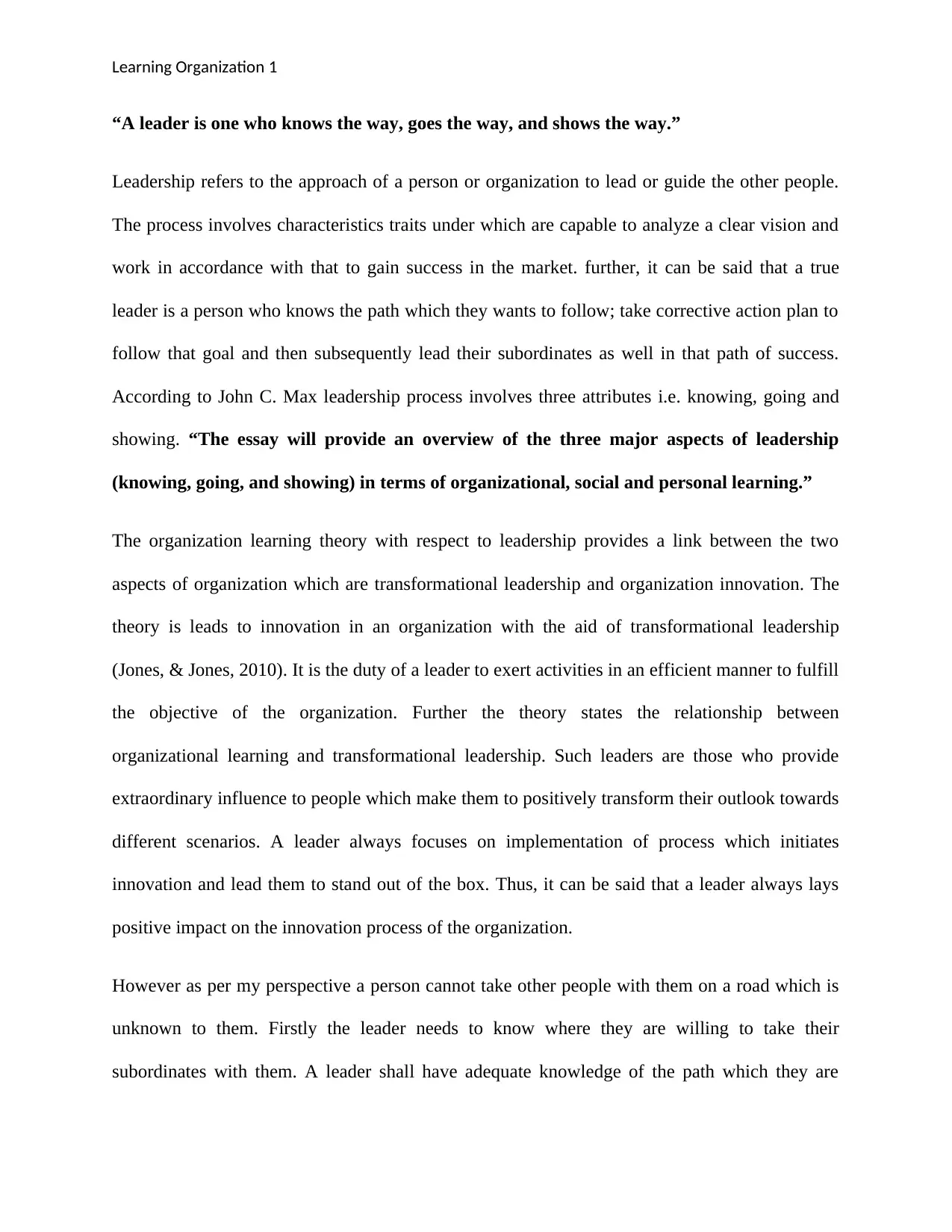
Learning Organization 1
“A leader is one who knows the way, goes the way, and shows the way.”
Leadership refers to the approach of a person or organization to lead or guide the other people.
The process involves characteristics traits under which are capable to analyze a clear vision and
work in accordance with that to gain success in the market. further, it can be said that a true
leader is a person who knows the path which they wants to follow; take corrective action plan to
follow that goal and then subsequently lead their subordinates as well in that path of success.
According to John C. Max leadership process involves three attributes i.e. knowing, going and
showing. “The essay will provide an overview of the three major aspects of leadership
(knowing, going, and showing) in terms of organizational, social and personal learning.”
The organization learning theory with respect to leadership provides a link between the two
aspects of organization which are transformational leadership and organization innovation. The
theory is leads to innovation in an organization with the aid of transformational leadership
(Jones, & Jones, 2010). It is the duty of a leader to exert activities in an efficient manner to fulfill
the objective of the organization. Further the theory states the relationship between
organizational learning and transformational leadership. Such leaders are those who provide
extraordinary influence to people which make them to positively transform their outlook towards
different scenarios. A leader always focuses on implementation of process which initiates
innovation and lead them to stand out of the box. Thus, it can be said that a leader always lays
positive impact on the innovation process of the organization.
However as per my perspective a person cannot take other people with them on a road which is
unknown to them. Firstly the leader needs to know where they are willing to take their
subordinates with them. A leader shall have adequate knowledge of the path which they are
“A leader is one who knows the way, goes the way, and shows the way.”
Leadership refers to the approach of a person or organization to lead or guide the other people.
The process involves characteristics traits under which are capable to analyze a clear vision and
work in accordance with that to gain success in the market. further, it can be said that a true
leader is a person who knows the path which they wants to follow; take corrective action plan to
follow that goal and then subsequently lead their subordinates as well in that path of success.
According to John C. Max leadership process involves three attributes i.e. knowing, going and
showing. “The essay will provide an overview of the three major aspects of leadership
(knowing, going, and showing) in terms of organizational, social and personal learning.”
The organization learning theory with respect to leadership provides a link between the two
aspects of organization which are transformational leadership and organization innovation. The
theory is leads to innovation in an organization with the aid of transformational leadership
(Jones, & Jones, 2010). It is the duty of a leader to exert activities in an efficient manner to fulfill
the objective of the organization. Further the theory states the relationship between
organizational learning and transformational leadership. Such leaders are those who provide
extraordinary influence to people which make them to positively transform their outlook towards
different scenarios. A leader always focuses on implementation of process which initiates
innovation and lead them to stand out of the box. Thus, it can be said that a leader always lays
positive impact on the innovation process of the organization.
However as per my perspective a person cannot take other people with them on a road which is
unknown to them. Firstly the leader needs to know where they are willing to take their
subordinates with them. A leader shall have adequate knowledge of the path which they are
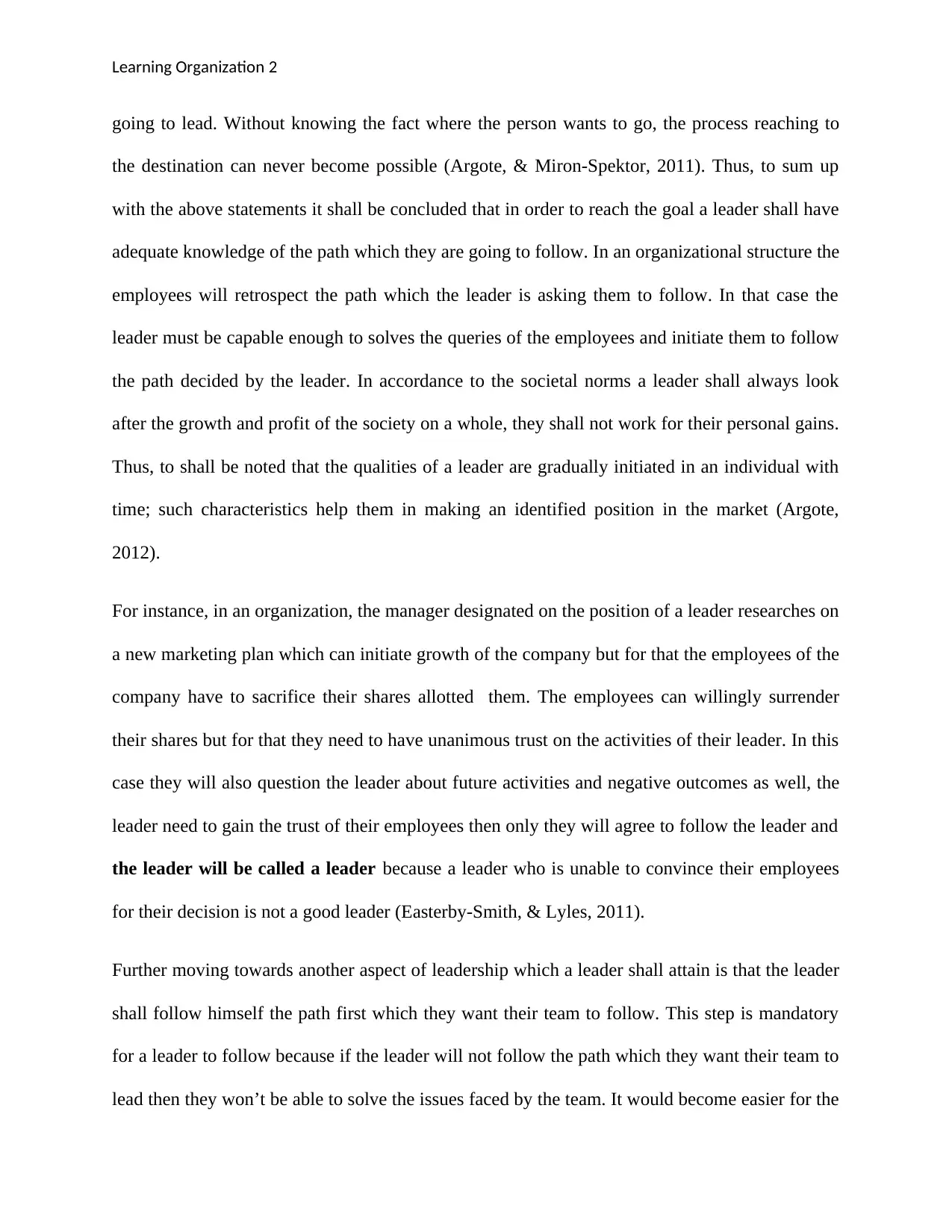
Learning Organization 2
going to lead. Without knowing the fact where the person wants to go, the process reaching to
the destination can never become possible (Argote, & Miron-Spektor, 2011). Thus, to sum up
with the above statements it shall be concluded that in order to reach the goal a leader shall have
adequate knowledge of the path which they are going to follow. In an organizational structure the
employees will retrospect the path which the leader is asking them to follow. In that case the
leader must be capable enough to solves the queries of the employees and initiate them to follow
the path decided by the leader. In accordance to the societal norms a leader shall always look
after the growth and profit of the society on a whole, they shall not work for their personal gains.
Thus, to shall be noted that the qualities of a leader are gradually initiated in an individual with
time; such characteristics help them in making an identified position in the market (Argote,
2012).
For instance, in an organization, the manager designated on the position of a leader researches on
a new marketing plan which can initiate growth of the company but for that the employees of the
company have to sacrifice their shares allotted them. The employees can willingly surrender
their shares but for that they need to have unanimous trust on the activities of their leader. In this
case they will also question the leader about future activities and negative outcomes as well, the
leader need to gain the trust of their employees then only they will agree to follow the leader and
the leader will be called a leader because a leader who is unable to convince their employees
for their decision is not a good leader (Easterby-Smith, & Lyles, 2011).
Further moving towards another aspect of leadership which a leader shall attain is that the leader
shall follow himself the path first which they want their team to follow. This step is mandatory
for a leader to follow because if the leader will not follow the path which they want their team to
lead then they won’t be able to solve the issues faced by the team. It would become easier for the
going to lead. Without knowing the fact where the person wants to go, the process reaching to
the destination can never become possible (Argote, & Miron-Spektor, 2011). Thus, to sum up
with the above statements it shall be concluded that in order to reach the goal a leader shall have
adequate knowledge of the path which they are going to follow. In an organizational structure the
employees will retrospect the path which the leader is asking them to follow. In that case the
leader must be capable enough to solves the queries of the employees and initiate them to follow
the path decided by the leader. In accordance to the societal norms a leader shall always look
after the growth and profit of the society on a whole, they shall not work for their personal gains.
Thus, to shall be noted that the qualities of a leader are gradually initiated in an individual with
time; such characteristics help them in making an identified position in the market (Argote,
2012).
For instance, in an organization, the manager designated on the position of a leader researches on
a new marketing plan which can initiate growth of the company but for that the employees of the
company have to sacrifice their shares allotted them. The employees can willingly surrender
their shares but for that they need to have unanimous trust on the activities of their leader. In this
case they will also question the leader about future activities and negative outcomes as well, the
leader need to gain the trust of their employees then only they will agree to follow the leader and
the leader will be called a leader because a leader who is unable to convince their employees
for their decision is not a good leader (Easterby-Smith, & Lyles, 2011).
Further moving towards another aspect of leadership which a leader shall attain is that the leader
shall follow himself the path first which they want their team to follow. This step is mandatory
for a leader to follow because if the leader will not follow the path which they want their team to
lead then they won’t be able to solve the issues faced by the team. It would become easier for the
⊘ This is a preview!⊘
Do you want full access?
Subscribe today to unlock all pages.

Trusted by 1+ million students worldwide
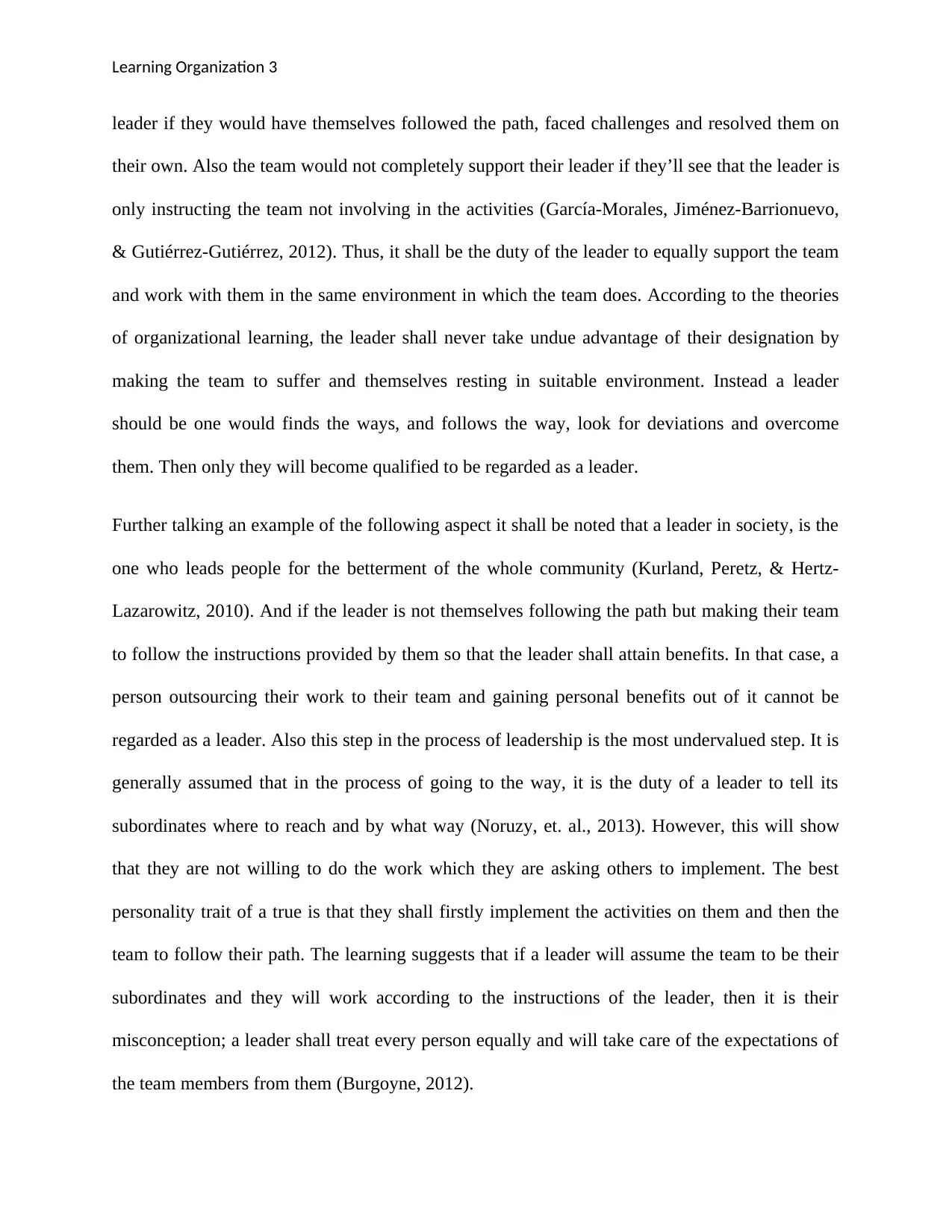
Learning Organization 3
leader if they would have themselves followed the path, faced challenges and resolved them on
their own. Also the team would not completely support their leader if they’ll see that the leader is
only instructing the team not involving in the activities (García-Morales, Jiménez-Barrionuevo,
& Gutiérrez-Gutiérrez, 2012). Thus, it shall be the duty of the leader to equally support the team
and work with them in the same environment in which the team does. According to the theories
of organizational learning, the leader shall never take undue advantage of their designation by
making the team to suffer and themselves resting in suitable environment. Instead a leader
should be one would finds the ways, and follows the way, look for deviations and overcome
them. Then only they will become qualified to be regarded as a leader.
Further talking an example of the following aspect it shall be noted that a leader in society, is the
one who leads people for the betterment of the whole community (Kurland, Peretz, & Hertz-
Lazarowitz, 2010). And if the leader is not themselves following the path but making their team
to follow the instructions provided by them so that the leader shall attain benefits. In that case, a
person outsourcing their work to their team and gaining personal benefits out of it cannot be
regarded as a leader. Also this step in the process of leadership is the most undervalued step. It is
generally assumed that in the process of going to the way, it is the duty of a leader to tell its
subordinates where to reach and by what way (Noruzy, et. al., 2013). However, this will show
that they are not willing to do the work which they are asking others to implement. The best
personality trait of a true is that they shall firstly implement the activities on them and then the
team to follow their path. The learning suggests that if a leader will assume the team to be their
subordinates and they will work according to the instructions of the leader, then it is their
misconception; a leader shall treat every person equally and will take care of the expectations of
the team members from them (Burgoyne, 2012).
leader if they would have themselves followed the path, faced challenges and resolved them on
their own. Also the team would not completely support their leader if they’ll see that the leader is
only instructing the team not involving in the activities (García-Morales, Jiménez-Barrionuevo,
& Gutiérrez-Gutiérrez, 2012). Thus, it shall be the duty of the leader to equally support the team
and work with them in the same environment in which the team does. According to the theories
of organizational learning, the leader shall never take undue advantage of their designation by
making the team to suffer and themselves resting in suitable environment. Instead a leader
should be one would finds the ways, and follows the way, look for deviations and overcome
them. Then only they will become qualified to be regarded as a leader.
Further talking an example of the following aspect it shall be noted that a leader in society, is the
one who leads people for the betterment of the whole community (Kurland, Peretz, & Hertz-
Lazarowitz, 2010). And if the leader is not themselves following the path but making their team
to follow the instructions provided by them so that the leader shall attain benefits. In that case, a
person outsourcing their work to their team and gaining personal benefits out of it cannot be
regarded as a leader. Also this step in the process of leadership is the most undervalued step. It is
generally assumed that in the process of going to the way, it is the duty of a leader to tell its
subordinates where to reach and by what way (Noruzy, et. al., 2013). However, this will show
that they are not willing to do the work which they are asking others to implement. The best
personality trait of a true is that they shall firstly implement the activities on them and then the
team to follow their path. The learning suggests that if a leader will assume the team to be their
subordinates and they will work according to the instructions of the leader, then it is their
misconception; a leader shall treat every person equally and will take care of the expectations of
the team members from them (Burgoyne, 2012).
Paraphrase This Document
Need a fresh take? Get an instant paraphrase of this document with our AI Paraphraser
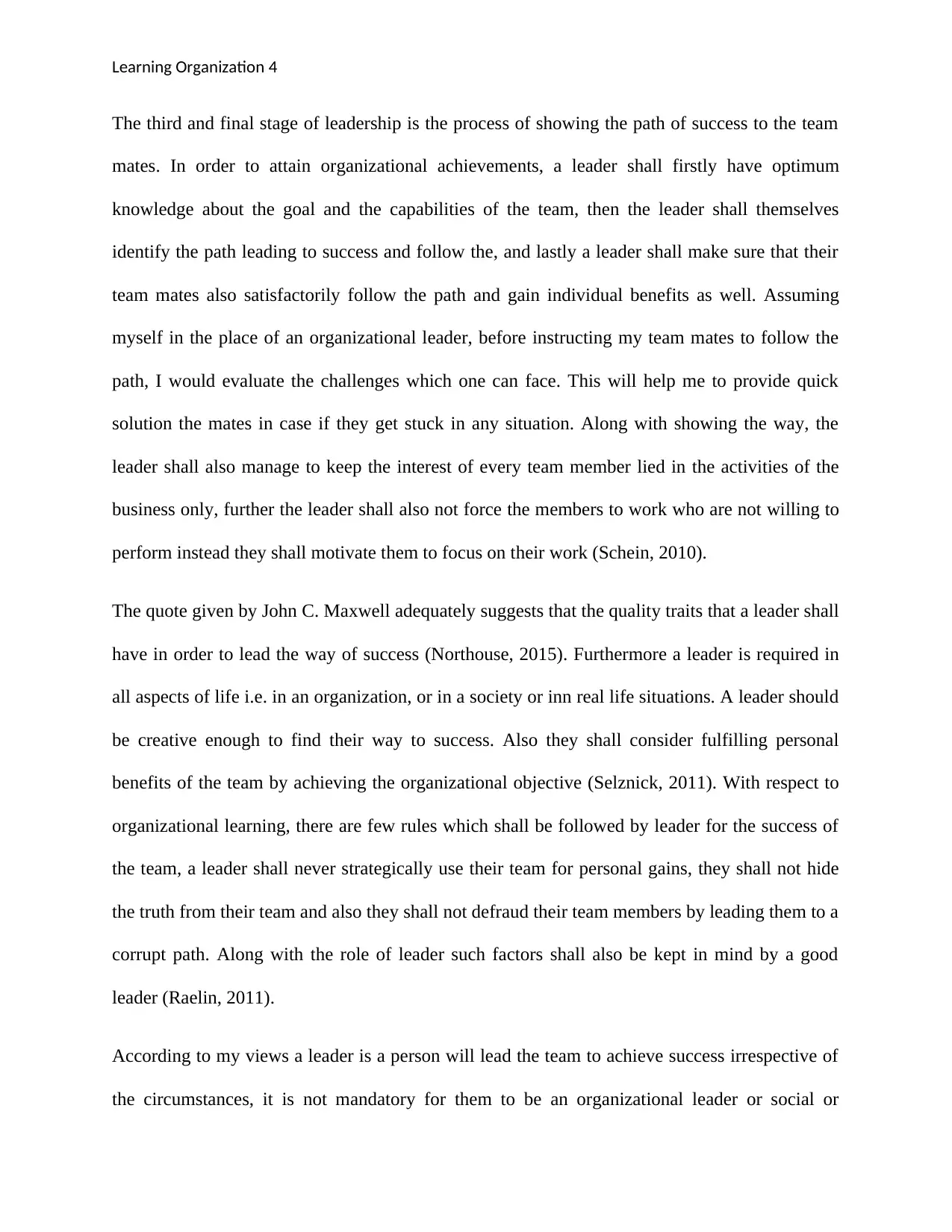
Learning Organization 4
The third and final stage of leadership is the process of showing the path of success to the team
mates. In order to attain organizational achievements, a leader shall firstly have optimum
knowledge about the goal and the capabilities of the team, then the leader shall themselves
identify the path leading to success and follow the, and lastly a leader shall make sure that their
team mates also satisfactorily follow the path and gain individual benefits as well. Assuming
myself in the place of an organizational leader, before instructing my team mates to follow the
path, I would evaluate the challenges which one can face. This will help me to provide quick
solution the mates in case if they get stuck in any situation. Along with showing the way, the
leader shall also manage to keep the interest of every team member lied in the activities of the
business only, further the leader shall also not force the members to work who are not willing to
perform instead they shall motivate them to focus on their work (Schein, 2010).
The quote given by John C. Maxwell adequately suggests that the quality traits that a leader shall
have in order to lead the way of success (Northouse, 2015). Furthermore a leader is required in
all aspects of life i.e. in an organization, or in a society or inn real life situations. A leader should
be creative enough to find their way to success. Also they shall consider fulfilling personal
benefits of the team by achieving the organizational objective (Selznick, 2011). With respect to
organizational learning, there are few rules which shall be followed by leader for the success of
the team, a leader shall never strategically use their team for personal gains, they shall not hide
the truth from their team and also they shall not defraud their team members by leading them to a
corrupt path. Along with the role of leader such factors shall also be kept in mind by a good
leader (Raelin, 2011).
According to my views a leader is a person will lead the team to achieve success irrespective of
the circumstances, it is not mandatory for them to be an organizational leader or social or
The third and final stage of leadership is the process of showing the path of success to the team
mates. In order to attain organizational achievements, a leader shall firstly have optimum
knowledge about the goal and the capabilities of the team, then the leader shall themselves
identify the path leading to success and follow the, and lastly a leader shall make sure that their
team mates also satisfactorily follow the path and gain individual benefits as well. Assuming
myself in the place of an organizational leader, before instructing my team mates to follow the
path, I would evaluate the challenges which one can face. This will help me to provide quick
solution the mates in case if they get stuck in any situation. Along with showing the way, the
leader shall also manage to keep the interest of every team member lied in the activities of the
business only, further the leader shall also not force the members to work who are not willing to
perform instead they shall motivate them to focus on their work (Schein, 2010).
The quote given by John C. Maxwell adequately suggests that the quality traits that a leader shall
have in order to lead the way of success (Northouse, 2015). Furthermore a leader is required in
all aspects of life i.e. in an organization, or in a society or inn real life situations. A leader should
be creative enough to find their way to success. Also they shall consider fulfilling personal
benefits of the team by achieving the organizational objective (Selznick, 2011). With respect to
organizational learning, there are few rules which shall be followed by leader for the success of
the team, a leader shall never strategically use their team for personal gains, they shall not hide
the truth from their team and also they shall not defraud their team members by leading them to a
corrupt path. Along with the role of leader such factors shall also be kept in mind by a good
leader (Raelin, 2011).
According to my views a leader is a person will lead the team to achieve success irrespective of
the circumstances, it is not mandatory for them to be an organizational leader or social or
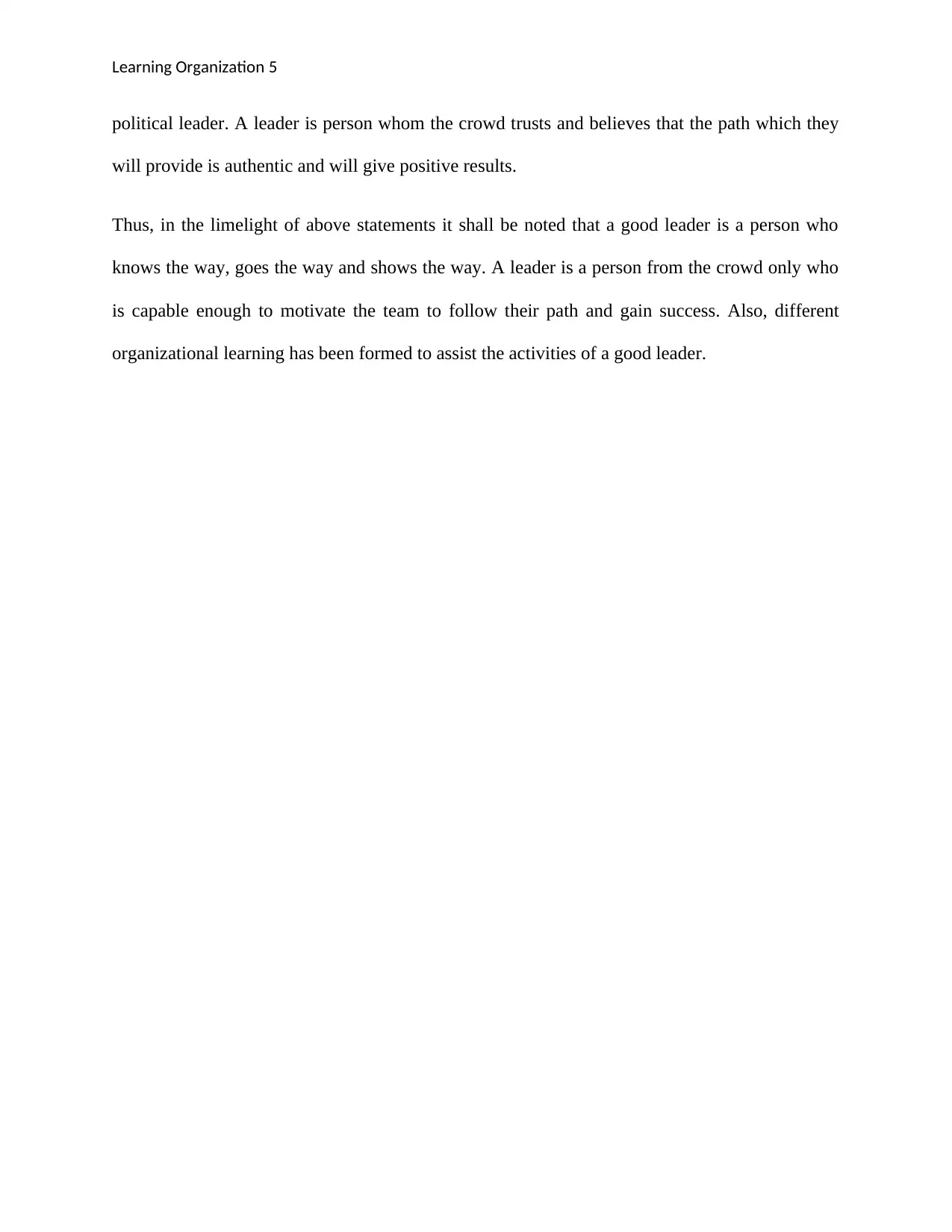
Learning Organization 5
political leader. A leader is person whom the crowd trusts and believes that the path which they
will provide is authentic and will give positive results.
Thus, in the limelight of above statements it shall be noted that a good leader is a person who
knows the way, goes the way and shows the way. A leader is a person from the crowd only who
is capable enough to motivate the team to follow their path and gain success. Also, different
organizational learning has been formed to assist the activities of a good leader.
political leader. A leader is person whom the crowd trusts and believes that the path which they
will provide is authentic and will give positive results.
Thus, in the limelight of above statements it shall be noted that a good leader is a person who
knows the way, goes the way and shows the way. A leader is a person from the crowd only who
is capable enough to motivate the team to follow their path and gain success. Also, different
organizational learning has been formed to assist the activities of a good leader.
⊘ This is a preview!⊘
Do you want full access?
Subscribe today to unlock all pages.

Trusted by 1+ million students worldwide
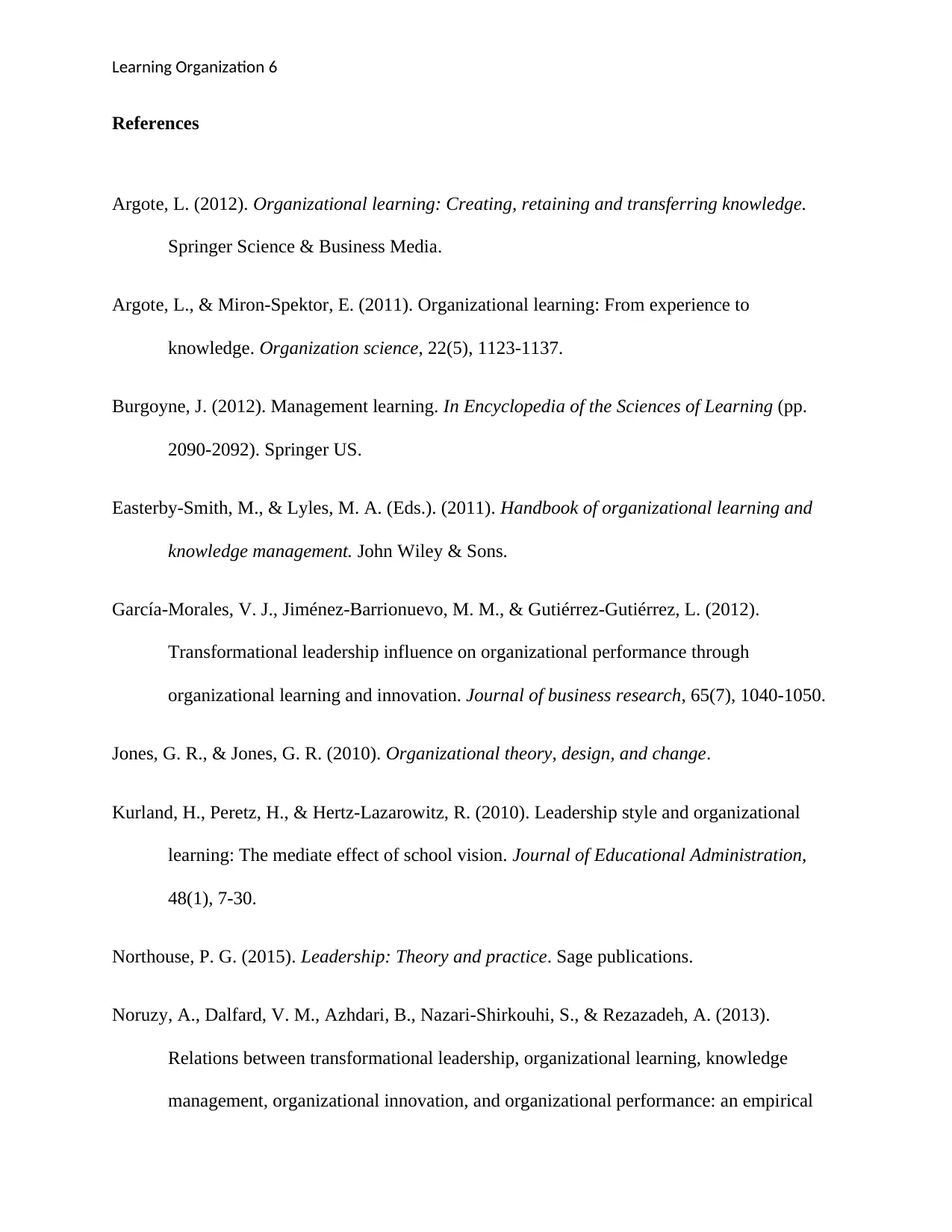
Learning Organization 6
References
Argote, L. (2012). Organizational learning: Creating, retaining and transferring knowledge.
Springer Science & Business Media.
Argote, L., & Miron-Spektor, E. (2011). Organizational learning: From experience to
knowledge. Organization science, 22(5), 1123-1137.
Burgoyne, J. (2012). Management learning. In Encyclopedia of the Sciences of Learning (pp.
2090-2092). Springer US.
Easterby-Smith, M., & Lyles, M. A. (Eds.). (2011). Handbook of organizational learning and
knowledge management. John Wiley & Sons.
García-Morales, V. J., Jiménez-Barrionuevo, M. M., & Gutiérrez-Gutiérrez, L. (2012).
Transformational leadership influence on organizational performance through
organizational learning and innovation. Journal of business research, 65(7), 1040-1050.
Jones, G. R., & Jones, G. R. (2010). Organizational theory, design, and change.
Kurland, H., Peretz, H., & Hertz-Lazarowitz, R. (2010). Leadership style and organizational
learning: The mediate effect of school vision. Journal of Educational Administration,
48(1), 7-30.
Northouse, P. G. (2015). Leadership: Theory and practice. Sage publications.
Noruzy, A., Dalfard, V. M., Azhdari, B., Nazari-Shirkouhi, S., & Rezazadeh, A. (2013).
Relations between transformational leadership, organizational learning, knowledge
management, organizational innovation, and organizational performance: an empirical
References
Argote, L. (2012). Organizational learning: Creating, retaining and transferring knowledge.
Springer Science & Business Media.
Argote, L., & Miron-Spektor, E. (2011). Organizational learning: From experience to
knowledge. Organization science, 22(5), 1123-1137.
Burgoyne, J. (2012). Management learning. In Encyclopedia of the Sciences of Learning (pp.
2090-2092). Springer US.
Easterby-Smith, M., & Lyles, M. A. (Eds.). (2011). Handbook of organizational learning and
knowledge management. John Wiley & Sons.
García-Morales, V. J., Jiménez-Barrionuevo, M. M., & Gutiérrez-Gutiérrez, L. (2012).
Transformational leadership influence on organizational performance through
organizational learning and innovation. Journal of business research, 65(7), 1040-1050.
Jones, G. R., & Jones, G. R. (2010). Organizational theory, design, and change.
Kurland, H., Peretz, H., & Hertz-Lazarowitz, R. (2010). Leadership style and organizational
learning: The mediate effect of school vision. Journal of Educational Administration,
48(1), 7-30.
Northouse, P. G. (2015). Leadership: Theory and practice. Sage publications.
Noruzy, A., Dalfard, V. M., Azhdari, B., Nazari-Shirkouhi, S., & Rezazadeh, A. (2013).
Relations between transformational leadership, organizational learning, knowledge
management, organizational innovation, and organizational performance: an empirical
Paraphrase This Document
Need a fresh take? Get an instant paraphrase of this document with our AI Paraphraser
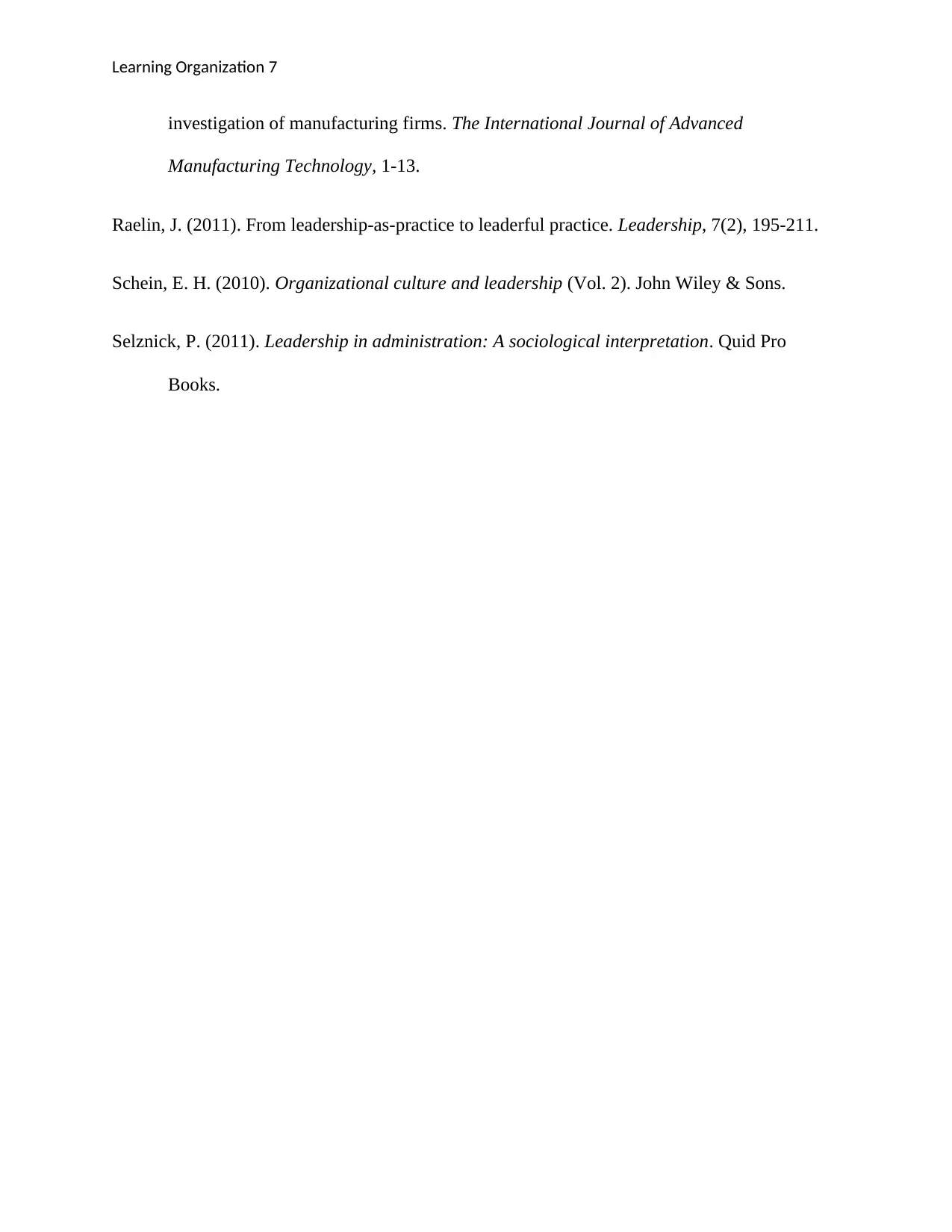
Learning Organization 7
investigation of manufacturing firms. The International Journal of Advanced
Manufacturing Technology, 1-13.
Raelin, J. (2011). From leadership-as-practice to leaderful practice. Leadership, 7(2), 195-211.
Schein, E. H. (2010). Organizational culture and leadership (Vol. 2). John Wiley & Sons.
Selznick, P. (2011). Leadership in administration: A sociological interpretation. Quid Pro
Books.
investigation of manufacturing firms. The International Journal of Advanced
Manufacturing Technology, 1-13.
Raelin, J. (2011). From leadership-as-practice to leaderful practice. Leadership, 7(2), 195-211.
Schein, E. H. (2010). Organizational culture and leadership (Vol. 2). John Wiley & Sons.
Selznick, P. (2011). Leadership in administration: A sociological interpretation. Quid Pro
Books.
1 out of 8
Related Documents
Your All-in-One AI-Powered Toolkit for Academic Success.
+13062052269
info@desklib.com
Available 24*7 on WhatsApp / Email
![[object Object]](/_next/static/media/star-bottom.7253800d.svg)
Unlock your academic potential
Copyright © 2020–2025 A2Z Services. All Rights Reserved. Developed and managed by ZUCOL.





